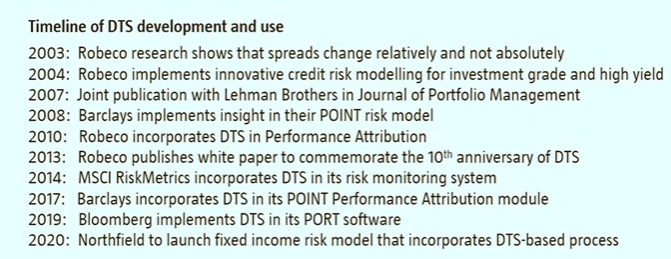Robeco researchers1 developed an innovative method in 2003 to predict credit volatility more adaptively and more granularly. Although no model is ever perfect, the new methodology substantially improved the measurement of credit volatility compared to the traditional models at the time.
Also read: Duration Times Spread: a measure of spread exposure in credit portfoliosThe methodology, Duration Times Spread (DTS), has become the industry standard for measuring the credit volatility of a corporate bond. It measures the sensitivity of the price of a bond to relative changes in credit spread, and is a single number that can be used to compare credit volatility across a wide range of bonds. In practice, it is applied in the portfolio management process to assess relative value, manage risk exposure in portfolio construction and conduct performance attribution.
Not all spread-durations are equal
Traditional risk models typically rely on the extrapolation of historical trends. An example is the use of volatility in returns over the most recent 36 months. One disadvantage of such an approach is that it fails to capture true risk when there is a break in the trend2.
For example, at the onset of the financial crisis in 2007, the output of such models would still have been based mainly on data from the quiet periods of 2005 and 2006, when credit spreads were relatively stable, and would have vastly underestimated the risk of a credit portfolio.
Similarly, immediately following a volatile period of large changes in credit spread, a traditional model that relies on historical returns would overestimate risk.
A further problem is that traditional risk measurement models tend to use an absolute approach, and do not account for the fact that the magnitude of spread changes are proportional to spread levels: bonds with wider spreads are riskier because they experience greater spread changes. Accurate risk measurement would thus need to factor in the sensitivity of returns to relative changes in spread.
Traditional models, moreover, are unable to weigh up different types of risk. Credit investors know that longer-dated credit is riskier than shorter-dated credit. They also know that bonds issued by lower-rated names are riskier than higher-quality credits. The difficulty is in comparing these two sources of risk: how, for example, does one rate the risk associated with a short-dated B-rated credit against the risk of a long-dated AA-rated credit?
“
The empirical observation that spreads move in a relative rather than an absolute fashion is at the heart of our DTS methodology
Calculating Duration Times Spread
The empirical observation that credit spreads move in a relative rather than an absolute fashion is at the heart of our DTS methodology. If higher-spread sectors represent greater exposure to sector-specific risks, then not all spread-durations are equal.
Our in-depth research shows that the risk of a bond – its future price volatility – is best measured by the product of its spread-duration and its spread, which is the DTS.
DTS = bond spread x duration spread of the bond
For example, a bond with one-year duration and a spread of 500 basis points has the same expected volatility (1 x 500 = 500) as a bond with five-year duration and spread of 100 basis points (5 x 100 = 500).
As our risk estimates based on this calculation depend directly on the observed spread, they react instantaneously to market turmoil, and so are more accurate than estimates based on recent history.
The simplicity of the DTS allows for a wide application. As it provides a single measurement, this method can be used to compare the exposure to the credit spreads of different types of credit assets – regardless of rating or maturity, for instance. It can also be used to compare the risk profile of different credit portfolios. The higher the DTS of a credit asset or a credit portfolio, the more its returns will decline in the event credit spreads widen.
Its versatility of use means that DTS is as important for credit investors as duration is for all fixed income investors.
Industry standard for risk measurement
The DTS concept is used for all of Robeco’s credit-related segments in its fixed income portfolios3. It is also applied broadly throughout the industry and has been implemented in leading risk management software, including MSCI RiskMetrics and Bloomberg PORT.

Specifically, we apply DTS to four key aspects of our portfolio management process, namely risk measurement, assessing relative value, portfolio construction and performance attribution.
A powerful tool
We consider DTS to be an accurate methodology for forecasting credit volatility, although on occasion it can be inclined to over- and underestimate risk. By using it in our credit investment processes, portfolio managers are able to construct well-diversified portfolios in which the risk contributions of their high-conviction positions are measured accurately.
Moreover, risk-adjusted returns can be calculated almost in real time, allowing timely relative value assessment.
Finally, we consider this a tool that allows for portfolio positions to be evaluated periodically in the same framework as they have been implemented, yielding important insights and possibly giving rise to re-evaluation of these positions.
Footnotes
1 A joint project with Lehman Brothers led to the publication of the result; see: Ben Dor, A., Dynkin, L., Hyman, J., Houweling, P., Van Leeuwen, E., and Penninga, O., ‘DTS (Duration Times Spread)’, The Journal of Portfolio Management, 2007, vol. 33. no. 2, pp. 77-100. Downloadable here.
2 See Beekhuizen, P. and Houweling, P., ‘Smart Credit Investing - Risk Points and Their Applications’, Robeco White Paper, 2013, December.
3 See ‘Guide to credits: The Robeco approach’.


